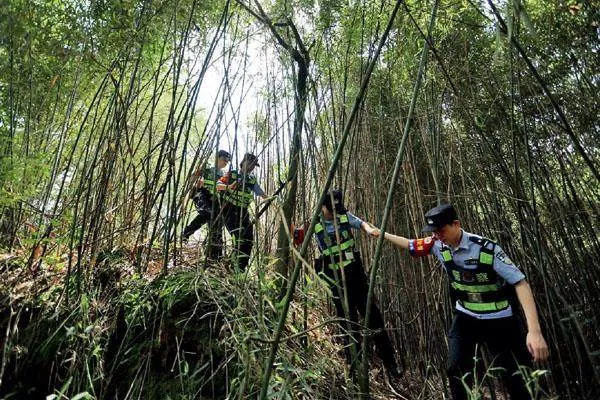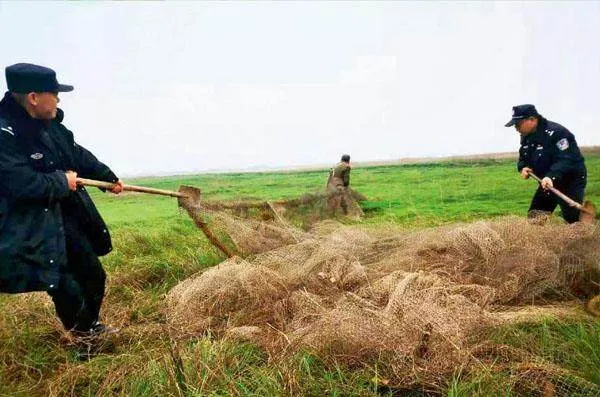江西 创新大湖治理模式 守护候鸟希望家园







鄱阳湖位于长江中下游南岸、江西省北部,为中国最大的淡水湖。滨湖涉及南昌、九江、上饶3个设区市及南昌、新建、进贤、永修、共青城、庐山、濂溪、湖口、都昌、鄱阳、余干、万年12个县(市、区),沿湖涉水乡镇98个,人口 360余万人。鄱阳湖是一个吞吐型、季节性的湖泊,不同季节湖体面积相差极大,丰水期最高水位时,湖体面积约4550平方公里,枯水期最低水位时仅239平方公里。鄱阳湖水系流域上承接赣河、抚河、信河、饶河、修河五河之水,经九江市湖口县域注入长江,年平均径流量约占长江径流量的15%。
鄱阳湖既是我国最大的淡水湖,也是整个“东亚一澳大利西亚”候鸟迁飞区中最重要的候鸟栖息地。鄱阳湖“丰水一片,枯水一线”的自然水文节律和枯水期星罗棋布的碟形湖是吸引这些鸟类前来的重要因素。得天独厚的自然条件使鄱阳湖成为世界自然基金会划定的全球重要生态区之一,现有鸟类310种,素有“白鹤世界”“珍禽王国”和“候鸟天堂”的美誉。淡水鱼种类150余种,贝类87种,水生维管束植物102种,在长江流域发挥着巨大的调蓄洪水和保护生物多样性等特殊生态功能。
作为东亚最重要的候鸟栖息地,每年有70余万只候鸟在此过冬。在鄱阳湖的众多鸟类中,白鹤不仅是鄱阳湖的明星物种,也是江西省的省鸟,是江西最有代表性的野生动物之一。
白鹤是一种全球性极危的大型涉禽,它们夏季在俄罗斯西伯利亚繁衍后代,秋季南下越冬。在过去,南亚的印度、西亚的伊朗和我国长江中下游湿地都有白鹤的越冬种群,但由于生态环境丧失和偷猎等原因,如今全世界90%的白鹤都聚集在鄱阳湖越冬,每年的种群数量超过5000只,鄱阳湖成了这个物种延续最后的希望之地。
白鹤等珍稀候鸟的选择,成为鄱阳湖生态环境逐年改善的最佳“代言人”与注解。鄱阳湖不仅成为种类繁多的鸟类赖以生存的家园,也是长江江豚和许多鱼类的庇护所。
5月,本刊记者沿鄱阳湖走访了九江、上饶、南昌等市县区,了解江西公安在深化联谊联防机制,创新大湖治理模式,为打造国家生态文明建设高地贡献公安力量的具体举措。
鄱阳湖区联谊联防联治机制
鄱阳湖交界市、县多、管理部门多,为了解决“九龙治水”问题,防止出现地方保护主义和推诿塞责现象,2003年,在江西省委、政法委的统一部署下,成立了江西省公安厅等8个省直部门及南昌、九江、上饶3个设区市,12个滨湖县(市、区)党委、政府参与的鄱阳湖区联谊联防联治工作领导小组,小组办公室设在江西省公安厅水警总队,负责统筹协调鄱阳湖的综合治理工作。
20年多来,联谊联防联治工作领导小组每年在沿湖12县(市、区)轮流召开一次年会,总结经验,表彰先进,分析形势,研究部署下一步工作,并向沿湖12个县(市、区)党政主要领导下发《湖区矛盾问题化解整治暨基层基础建设责任书》,压实地方党委政府“属地管理”主体责任,源头化解湖区矛盾纠纷,推进地区和部门基层基础建设。省、市、县、乡四级牢固树立全省“一盘棋”思想,由各自为政到通力协作,严防严打湖区非法捕捞、非法采砂、非法猎杀候鸟、非法围堰等突出问题,创建了感情联谊、治安联防、纠纷联调、问题联治、平安联建的湖区综合治理新机制。湖区逐步实现了由乱到治、由治到安,“大打三六九、小打天天有”的治安乱象得到有效治理。
鄱阳湖禁捕退捕后,湖区没有发生捕捞权属纠纷,退捕过程十分平稳,湖区社会治安持续稳定,生态环境明显改善。联谊联防联治机制成为江西省“大湖治理”特色品牌,得到中央政法委、公安部的充分肯定。
鄱阳湖联合巡逻执法
为了更好地提高鄱阳湖区快速反应能力,在江西省委政法委的部署指挥下,2016年6月,江西省公安厅牵头江西省农业农村厅、省水利厅、省交通运输厅、省林业局在鄱阳湖蛇山岛设立省级联合巡逻执法点。2019年7月,设在蛇山岛的联勤指挥中心正式投入使用。
蛇山岛原为鄱阳湖上一座无人居住的小岛,占地面积169亩,地处南昌市新建区、九江市都昌县、上饶市鄱阳县、余干县3市4县交界的鄱阳湖交通要道,行政区划为都昌县管辖。蛇山岛东面是鄱阳县双港镇、莲湖乡,南面是余干县康山乡,西面是新建区南矶山乡,北面是都昌县周溪镇,蛇山岛位于湖区中央位置,到各个方向距离和用时接近。该水域鱼类资源丰富,水域界限交叉不清,历来是渔民捕捞场所的必争之地,历史上曾多次发生纠纷械斗事件。
为维护鄱阳湖的安全与生态保护,九江市设立1个市级联合巡逻执法点,新建、都昌、永修、鄱阳、余干5个县设立县级联合巡逻执法点,与省级联合巡逻执法遥相呼应、互为支援,打造最快出警处置圈。至今,沿湖12个县均建立了联合巡逻执法点,并推广到沿长江4个县,实现了沿江沿湖全覆盖。
其中,省级联合巡逻执法点实行周轮班制,每周分别由公安厅、农业农村厅、水利厅、交通运输厅1名处级干部带队,公安、农业农村、水利、交通运输、林业厅派1名干部参与。每天24小时利用雷达、视频监控、船、车、无人机对湖区重点水域开展动态巡逻执法,现场发现问题、查处案件、调处纠纷,调度各县级联合巡逻执法点在当地水域开展巡逻执法。联合巡逻执法点的设立,有效解决了发现不了、控制不住、处置不及时的问题,大量矛盾纠纷在初始阶段就被化解,为湖区安全稳定和生态改善发挥了不可替代的作用,丰富了江西省“大湖治理”的特色品牌。
打击生态资源犯罪 推动长江大保护
2020年1月,中央做出长江流域重点水域禁捕(以下称“十年禁渔”)重大决策部署后,江西省公安厅在省委、省政府和公安部的坚强领导下,在全国率先成立省、市、县三级公安长江大保护工作机构,以前所未有的重视程度、前所未有的工作力度,严防严打非法捕捞、非法采砂、非法猎杀候鸟等破坏湖区生态资源犯罪行为,整治湖区突出问题,推动湖区执法基层基础建设。
2020年以来,退捕渔民群体和渔区渔村保持稳定,湖区渔网、渔船星罗棋布的现象不复存在,连续多年未发生涉渔涉砂涉鸟重大案件。湖区水生生物多样性逐步丰富,鱼类种群结构进一步优化。如刀鱼数量明显增加,产卵个体数量增加并呈现二个高峰期;江豚种群稳中有升,幼豚比例上升。据2022年农业农村部监测,湖区江豚数量达492头,相比5年前增加35头,南昌水域都能看到江豚。
2020年以来,江西禁捕退捕工作连续3年国家考核名列前茅。公安部刚公布的2022年度长江十年禁渔考核,江西公安位列全国第一方阵,努力为打造美丽中国“江西样板”贡献公安力量。
(责任编辑:张敏娇)
Jiangxi’s Innovation in Lake Managementto Protect Migratory Birds
Written by Zhang Minjiao, Gu Jing Correspondence by Zeng Fangzhou
Poyang Lake, China's largest freshwater lake, extends across the northern part of Jiangxi Province, south of the middle and lower reaches of the Yangtze River. Around 3.6 million people reside in 98 towns and 12 counties around the lake, each belonging to one of three cities: Nanchang, Jiujiang, and Shangrao. As a seasonal one, the lake covers areas varying greatly throughout the year, from 239 km2 in the dry season to 4,550 km2 in the flood season. The lake receives water from five rivers: the Gan River, Fu River, Xin River, Rao River, and Xiu River, and discharges into the Yangtze River through Hukou County of Jiujiang City, with an average annual runoff of about 15% that of the Yangtze River.
Due to its natural hydrological cycles of high and low water, especially its scattered disc-shaped lakes during the dry season, Poyang Lake has become the most important habitat for migratory birds on the route from East Asia to Australia. Often hailed as the "World of White Cranes",the "Kingdom of Rare Birds",and the "Heaven of Migratory Birds",this naturally endowed lake has been designated by the World Wide Fund for Nature (WWF) as a major global ecological reserve, sheltering 310 bird species. In addition, the lake also provides sanctuary for over 150 species of fresh fish, 87 species of shellfish, and 102 species of aquatic plants, serving the function of both flood control and biodiversity conservation along the Yangtze River.
As the most important habitat for migratory birds in East Asia, the lake attracts more than 700,000 birds to spend the winter. Prominent among these visitors is the Siberian white crane, an emblematic bird for Jiangxi Province and a symbol of its most iconic wildlife.
The Siberian white crane is a critically endangered large wading bird in the world. It breeds in Siberia, Russia during the summer and migrates south for the winter. Historically, these cranes had three wintering grounds: India, Iran, and the wetlands along the middle and lower reaches of China's Yangtze River. However, due to habitat loss and poaching, 90% of the global population (that's over 5,000 birds) seek refuge in Poyang Lake for the winter. The lake has become the species' last hope for survival.
The choice of these cranes, along with other rare migratory birds, is the best testimony and annotation to the constant ecological improvement of Poyang Lake. The lake is a haven not only for diverse birds, but also for the Yangtze finless porpoise and various fish species.
After visiting Jiujiang, Shangrao, Nanchang and other cities and counties along Poyang Lake in May, the editor of this magazine gained an insight into the work of Jiangxi's public security forces. They have been enhancing the coordination mechanisms and innovating the lake management strategies, thereby establishing the area as a national paragon of ecological conservation.
The Coordination Mechanism of Poyang Lake
To curb local protectionism and evasion of responsibility plaguing the overlapping jurisdictions of various counties and cities, the Poyang Lake Coordination Mechanism Task Force was established in 2003 under the collective guidance of the Jiangxi Provincial Party Committee and the Political and Legal Affairs Committee. Based at the Marine Police Brigade of the Jiangxi Provincial Public Security Department, the task force is dedicated to coordinating the comprehensive management of Poyang Lake through a collaborative approach involving 8 provincial departments, including the Jiangxi Provincial Public Security Department, 3 cities of Nanchang, Jiujiang and Shangrao, and 12 counties around the lake.
Over the past two decades, the task force has organised an annual meeting in each of the 12 counties along the lake on a rotating basis to summarise experiences, commend exemplary practices, and outline subsequent actions. It has issued the Responsibility Statement for Dispute Resolution and Grassroots Development around Poyang Lake to the Party and government leaders of the 12 counties, which has proven to be instrumental in reinforcing the accountability of the local Party committees in jurisdiction management, preventing conflicts and disputes at the source, and fostering the grassroots development of localities and relevant departments. Adhering to the province's holistic governance philosophy, all cities, counties, and townships along the lake have moved away from isolated management styles and embraced more collaborative approaches to combating illegal activities, such as fishing, sand mining, poaching migratory birds, and the construction of unauthorized cofferdams. With the introduction of the new comprehensive governance mechanism, the lake area has transitioned from a state of chaos to one of order and security.
Since the implementation of no-take and catch-and-release policies, no disputes over fishing rights have arisen in the lake area. The smooth execution of the policies has not only maintained social stability but also facilitated ecological progress. The coordination mechanism has been recognised by the Committee of Political and Legal Affairs under the Central Committee of the Communist Party of China and the Ministry of Public Security as a hallmark of Jiangxi's lake management approaches.
The Joint Patrol System of Poyang Lake
To improve the response capabilities of the lake area, a joint command centre was inaugurated on Sheshan Island in Poyang Lake in June 2016. This initiative, led by the Jiangxi Provincial Party Committee of Political and Legal Affairs and guided by the Jiangxi Provincial Public Security Department, was a collaborative effort among the Jiangxi Provincial Department of Agriculture and Rural Affairs, the Provincial Department of Water Resources, the Provincial Department of Transportation, and the Provincial Forestry Administration. To further bolster operational capacity, the Joint Patrol Command Centre on Sheshan Island was officially launched in July 2019.
Once an uninhabited island of 169 mu (approximately 11.27 hectares), Sheshan Island under the jurisdiction of Duchang County has now become a major passage of Poyang Lake at the junction of New Area of Nanchang City, Duchang County of Jiujiang City, Poyang County and Yugan County of Shangrao City. Right in the middle of the lake, the island is almost equally far to Shuanggang and Lianhu townships in Poyang County in the east, Kangshan Township in Yugan County in the south, Nanjishan Township in Xinjian District in the west, and Zhouxi Township in Duchang County in the north. With abundant fish resources, the waters, however, lack clear boundaries between the surrounding townships. The waters have always been a strategic point of contention, inducing multiple armed conflicts in history.
To complement and facilitate the provincial joint patrol and law enforcement, and to speed up the processing of cases, a city-level joint patrol team and five county-level teams have been established in the city of Jiujiang and the counties of XinJian, Duchang, Yongxiu, Poyang, and Yugan. These teams are tasked with maintaining the security and ecological protection of Poyang Lake. The joint patrol system has achieved full coverage across all 12 counties around Poyang Lake, and has been extended to 4 more counties along the Yangtze River.
Among the joint patrol teams at various levels, the provincial team operates on a weekly shift model, comprising four directors from the Public Security, Agriculture and Rural Development, Water Resources, and Transportation departments, and five members respectively from the previous departments and forestry department. Beside, they employ a range of surveillance and patrol tools around the clock, including radar, CCTV, boats, vehicles, and drones. Beyond meticulously monitoring critical waterways to identify issues and conduct immediate investigations and dispute mediations, they also make plans for joint patrol operations by the county-level teams. Together, these joint patrol teams have effectively tackled elusive problems and prevented numerous conflicts and disputes. They play an essential role in maintaining local safety and stability, and their substantial contributions to ecological enhancement have significantly enriched Jiangxi's approaches to lake management.
The Crackdown on Ecological Crimes
In January 2020, China's central government made a strategic decision: to ban fishing in the key waters of the Yangtze River for 10 years. In response, the Jiangxi Provincial Public Security Department, guided by the provincial Party Committee, the provincial government, and the Ministry of Public Security, spearheaded the establishment of a three-tiered public security agency linking the provincial, city, and county levels in the coordinated protection of the Yangtze River. This agency has steadfastly dedicated itself to cracking down on illegal activities detrimental to the lake's ecology, such as fishing, sand mining, and the hunting of migratory birds. While addressing these prominent problems, it has also helped promote grassroots law enforcement.
Since the implementation of the catch-and-release policy in 2020, the former fishermen and fishing villages have remained calm, and there have been no significant incidents of fishing, sand mining, or bird hunting. The fishing nets and boats that used 78b3febb706e95dbd335fd602677032e7dc502054a358d13c04f726cd0e6570eto dot the lake area have disappeared entirely. The lake area has also seen its aquatic biodiversity enriched and its fish population structure optimized. For instance, there has been a notable increase in the number of swordfish, with two distinct peaks: the spawning population and the finless porpoise population, with a higher ratio of juveniles. The Ministry of Agriculture and Rural Affairs reports that, as of 2022, there are 492 finless porpoises in the lake area, an increase of 35 from five years ago. The species is now visible across all the waters of Nanchang.
Jiangxi has secured it the top spot in enforcing no-catch and catch-and-release policies for three consecutive years since 2020. In the 2022 annual assessment of the enforcement of the Yangtze River's 10-year fishing ban newly released by the Ministry of Public Security, Jiangxi's public security sector was ranked at the forefront nationwide. This recognition highlights the pivotal contribution of the security sector in nurturing the "Jiangxi model",aligning with China's overarching initiative to build a more picturesque nation.
(Translated by Chen Xiaoying, School of Foreign Languages, Beijing Forestry University)

